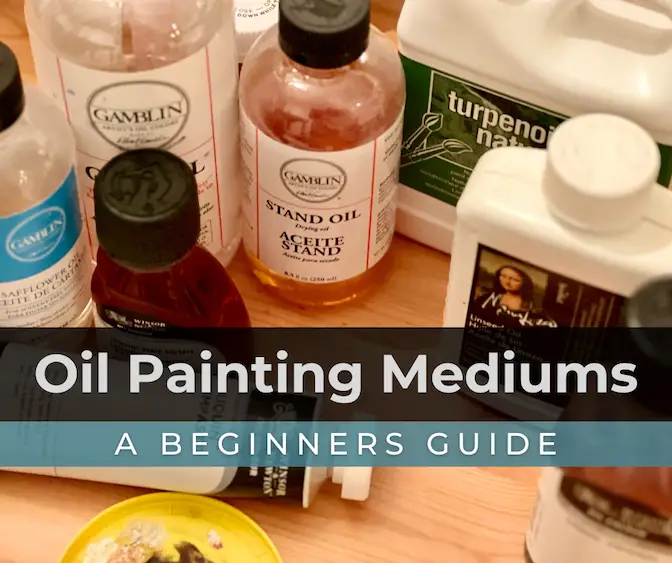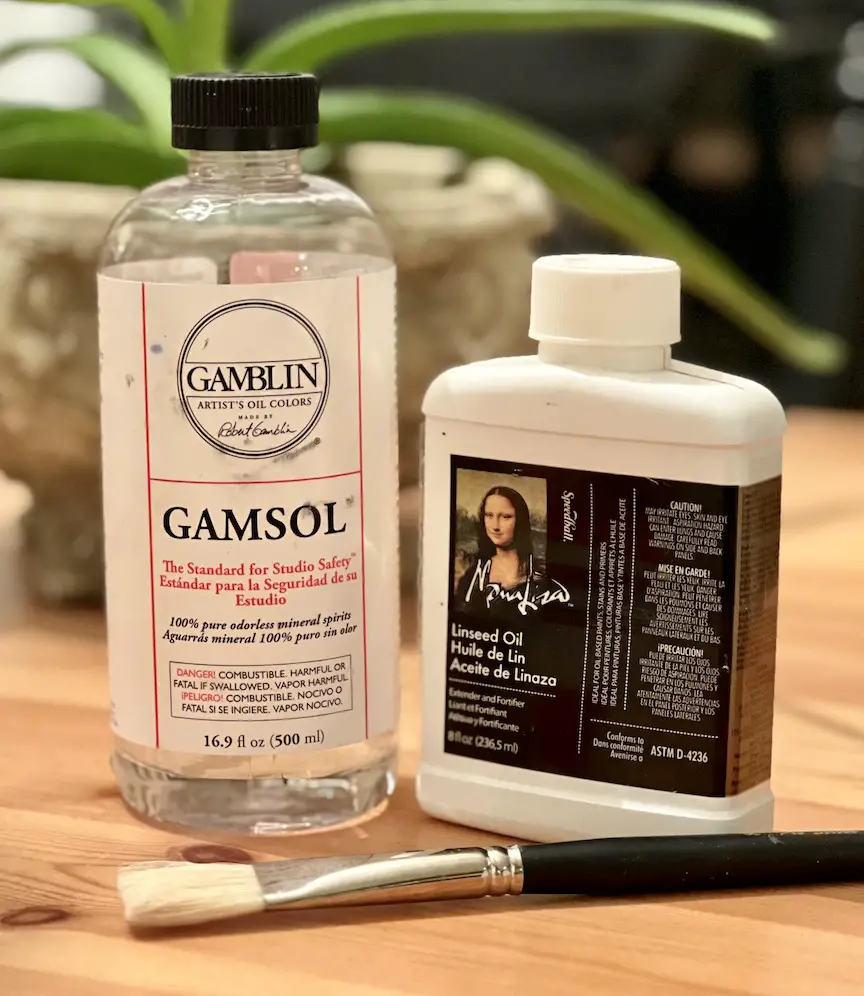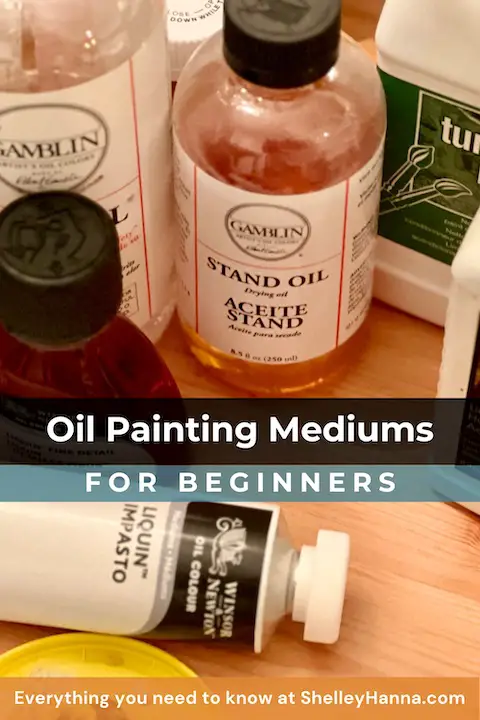Oil painting mediums are used to change the properties of paint. They thin oil paint, make it dry faster or slower, improve the flow, and increase the gloss or transparency. If you’re new to oil painting, learning about different mediums and how to use them will help you create the effects you want in your paintings.
When I started oil painting again, navigating all of the mediums to use had my head spinning. There is a lot to learn but my advice is to start with the most simple method and then build on that as you grow as an artist.
What are oil painting mediums?
Oil painting mediums are additives. They are made from natural or synthetic substances and used for a variety of purposes.
Note – some of the links in this post are affiliate links which means I may make a small commission if you use them. Thank you for supporting a fellow artist.
Common types of oil painting mediums
There are many different types of oil painting mediums, each with its own unique properties. Here are the most common ones:
- Linseed oil: Linseed oil is a popular medium for thinning oil paints and increasing their flow. If you want to keep things very simple, just use linseed oil. Many painters only use this oil and solvent (next on the list). Linseed oil also causes the paint dry slower.
- Odorless mineral spirits (OMS) and turpentine: OMS and turpentine are strong solvents used to thin oil paints and clean brushes. They can create a transparent effect, but be aware that they can also make the paint dry faster. I personally use Gamsol OMS as turpentine has a very strong odor and gives me a headache. I will use OMS at the beginning of my painting to thin down paint and sketch my subject.
- Alkyd mediums: Alkyd mediums like Liquin are synthetic mediums made with resin. Alkyds can thin or thicken paint, increase gloss, and speed up the drying time. They are generally more durable than traditional oil mediums and are less prone to yellowing. I’ve been using Liquin lately in some of my work and I can fully attest to the speedy drying time. I caution you to thoroughly clean your brushes after each session and also clean your palette. This stuff dries very hard and can be difficult to remove from work surfaces.
How to use oil painting mediums
Using a painting medium is easy. Simply mix it into your paint with a palette knife or brush. You can also mix different mediums together to get different effects. Just be aware that adding mediums to your paint will change its consistency and could affect the color, so it’s important to experiment and find the right balance for your needs.
I like to keep a ratio of 1 part medium to 4 or 5 parts paint in mind. Just be aware to start with thin layers and build up to thicker layers so the paint can dry evenly. And always follow the instructions on the label.
Tips for using oil painting mediums:
- Experiment: Each medium has its own unique properties, so it’s important to try out the medium as a test before starting your painting to see how it works.
- Start small: It’s best to start with a small amount of medium and gradually add more as needed. This will allow you to get a feel for how the medium affects the paint and make any adjustments.
- Be aware of consistency and color: Adding mediums to your paint will change its consistency and may affect the color. Being aware of this ahead of time will save you headaches later on. Some mediums thin out the paint while other mediums, such as Liquin Impasto, can thicken the paint and hold brush marks.
- Clean your brushes thoroughly after use: Oil painting mediums can be tough on brushes, so be sure to clean them thoroughly after use to extend their life. More about this later in the article.
- Store mediums properly: Make sure to store your mediums properly to prevent them from drying out or becoming contaminated. This will ensure that they are effective and ready to use when needed.
- Follow the instructions: Read and follow the instructions on the label of your mediums to make sure you are using them correctly and safely.
What medium speeds up drying time of oil paint?
- Solvents: Turpentine and odorless mineral spirits are solvents added to oil paints to thin them and make them dry faster. However, it’s important to use these mediums sparingly, as they can also weaken the paint and alter its properties.
- Alkyd resin mediums: Mediums like Liquin can be used to speed up the drying time of oil paints and also improve their flow. Made from alkyd resin and petroleum distillate, they create faster drying times. Drying varies between 1-6 days depending on the color and thickness of paint applied.
- Drying agents: Drying agents, such as Grumbacher Cobalt Drier, are added to oil paints to accelerate the drying process. It works by catalyzing chemical reactions that occur as the paint dries, which helps the paint to dry faster and more evenly. Use them sparingly to avoid cracking.
- Heat: Exposing an oil painting to heat can speed up the drying process. However, it’s important to use caution as heat can also cause the paint to crack or discolor. During the summer months, I allow my paintings to dry in the garage when it’s dry and hot outside. I put them flat inside a box to keep dust from sticking to the painting (of course, do not allow the box to come into contact with the paint surface). During colder months, I put smaller paintings in an oven with only the oven light on for heat. Do not heat up your oven. This could result in disaster.
Speeding up the drying time of oil paints can have some drawbacks. Oil paints take longer to dry than other types of paints because the drying process is more complex. The paint must not only dry on the surface, but the solvents in the paint must also evaporate. After that, the paint must undergo a chemical reaction known as “curing.” By speeding up the drying process, you may be sacrificing the full potential of the paint’s characteristics.
What medium slows down drying time in oil paint?
- Linseed oil: Linseed oil is a natural oil that is derived from flax seeds. It can slow down the drying time when mixed with paint and improve the paint’s flow. However, use it sparingly as it tends to yellow over time.
- Stand oil: This is a type of oil that has been heated to a high temperature and then allowed to cool slowly. It has the ability to slow down the drying time of oil paints and improve their gloss and flow. It causes less yellowing than linseed oil. Stand oil is also used to create a glossy, enamel-like finish on a painting.
- Cold wax medium: Cold wax medium is a paste made from a blend of beeswax, mineral spirits and a small amount of resin. When mixed with oil paints, it can slow down the drying time and create a matte, velvety finish. It can add a variety of textures to a painting and is best used on a rigid surface.
- Poppy oil: Like stand oil, poppy oil can be helpful if you want to work on a painting for an extended period of time. While Poppy oil also slows down drying time, it can dry more brittle, increasing the risk of cracking.
A general rule of thumb is the more oil you use in a painting, the longer the drying time. While that can be beneficial for many reasons, it can also make the painting more prone to smudging or smearing if it is not handled carefully.
What oil paint medium can be used for cleaning brushes?
- Solvents: Turpentine or odorless mineral spirits, are effective at dissolving and removing oil paint from brushes. However, they can also be harsh on the bristles and may weaken or damage the brush over time.
- Soap and water: Gentle soap and warm water can be used to clean oil paint from brushes, especially if the paint is still wet. Dish soap or a mild shampoo can work well for this purpose. I always use Murphy Oil Soap for cleaning my brushes. If they are especially dirty, I will let them soak in Murphy’s over night and then clean them.
- Brush cleaner: Brush cleaner is a specially formulated product that is designed to remove oil paint from brushes. It is made from a blend of solvents and surfactants that are gentle on the bristles and remove paint without damaging brushes. I’ve been using Master’s Brush Cleaner and Preserver with really good results.
- Oil: Surprise! Use oil to clean oil paint from brushes when the paint is still wet. Simply dip the brush in oil, work it into the bristles, and then wipe it clean with a cloth. This method can be effective, but it can also leave a residue on the brush. I like to make a brush dip out of Gamblin Safflower oil and a few drops of clove oil. After I paint, I wipe off my brush and dip them in the oil mixture so they are ready to go in the next day or two. The clove oil prevents the safflower oil from drying too fast. This is a great method if you don’t have a lot of down time between painting sessions.
What are the hazards of using medium in oil paint?
Hazards happen when mediums are not used correctly. Be aware of:
- Solvents: Many mediums for oil painting contain solvents, such as turpentine or mineral spirits, which can be harmful if inhaled or ingested. These solvents can also irritate the skin and eyes and may cause allergic reactions in some people.
- Flammability: Some mediums, such as linseed oil and stand oil, are flammable and should be used with caution. It is important to keep your work area well-ventilated and away from open flames or heat sources to reduce the risk of fire.
- Chemical reactions: Using mediums in the wrong combination can result in chemical reactions that produce toxic fumes or other hazards. It is important to research the properties of the mediums you are using and to follow all safety precautions when working with them.
- Allergies: Some people may be allergic to mediums or ingredients used in oil painting. It is important to be aware of any potential allergies or sensitivities and to take appropriate precautions when using mediums in your artwork.
Use caution when using mediums in oil painting and to follow all safety precautions to avoid the risk of accidents. This may include wearing protective gear, such as gloves and a mask, and working in a well-ventilated area.
It is also important to dispose of rags and towels with mediums and solvents in a safe way. Using a proper oily metal waste can like this one from Justrite is a good idea. I also will pour water on top of my discarded paper towels inside the bin to lower the risk of a chemical reaction.
Does a beginner oil painter need to use mediums?
Nope, although oil painters at all levels may find that using a little odorless mineral spirits and linseed oil is helpful while painting. However, it is not essential for beginners to use mediums. Many oil painters use the paint straight out of the tube. The paint already has a certain amount of medium mixed into it (usually linseed oil). Different brands and colors may have different consistencies though.
Some paint may come out of the tube very stiff and could use a touch of medium to help with the flow of the paint. Student grade oil paints may also contain more binders and fillers, reducing the pigment load. If you are just starting out and are still learning the basics of oil painting, you may find that you are able to achieve what you want with paint and brushes alone.
My suggestion is to have a small bottle of Gamsol and some linseed oil on hand at all times.
Summary: The pros and cons of using oil painting mediums
Pros:
- Thinning the paint: Mediums can help to thin the paint and improve the flow, making it easier to work with.
- Improving the gloss: Some mediums, such as stand oil, can increase the gloss and transparency of the paint, giving it a shiny, professional finish.
- Slowing down the drying time: Mediums such as stand oil and poppy oil can be used to slow down the drying time of the paint, giving you more time to work on your painting.
- Improves the paint’s flexibility: Some mediums, such as stand oil, can make the paint more flexible. This is helpful if you’re working on a large stretched canvas. Using canvas panels offers more stability overall.
Cons:
- Affecting the paint’s color: Adding mediums to your paint can slightly alter its color, so be mindful of this and make any necessary adjustments.
- Drying too fast: Some mediums, such as alkyds, can speed up the drying time. It’s not a problem if you like to work fast. But if you like to work slow and want to paint wet on wet, fast drying is a problem.
- Brittle paint and cracking: Using too much medium and not following the fat over lean rule can make the top layers of paint brittle and crack. If you look closely at paintings in museums, you can see where this has become a problem.
Experimenting with different mediums can help you find the right balance and achieve the effects you want in your paintings.
Time to paint
If you’d like to learn more about how to paint, check out some of my other articles:







